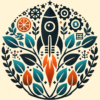Scaling Impact Through Systemic Collaboration and Radical Leadership
Today was the third session and second masterclass of the current 9-week sprint in the Americas–Europe–Africa cohort of EcoLaunch. As always, the cohort began with an intention-setting session and will conclude with a retrospective. In between, each week features a live session with global experts. This 9-week sprint is part of the broader 35-week EcoLaunch programme, designed to equip Nature-based and NatureTech entrepreneurs with the insight, confidence, and community to advance regenerative solutions for people and planet.
This masterclass featured two panellists offering grounded insights drawn from extensive lived experience and systems practice: Saskia Verraes and Tom Wilms.
Saskia spoke powerfully about the practice of radical collaboration. When resources are scarce and time is short, she suggested that this kind of collaboration isn’t just aspirational—it’s essential. Rather than competing for attention and credit, Saskia urged us to focus on purpose and build alignment around shared values. “If we all bind together for a bigger pot of money,” she noted, “we can decide ourselves how we divide it, and we all accelerate each other.” Her work draws on the concept of micro leadership—cultivating distributed leadership at all levels of an organisation—and virtual volunteering as a means of scaling impact without expanding bureaucracy.
Tom Wilms brought a different but deeply complementary lens, grounded in integrated coastal zone management. He introduced a practical, iterative approach to designing Nature-based Solutions that accounts for hydrological, socio-economic, and institutional systems from the start. Rather than locking in one solution too early, he advised: “Use that integrated design approach to avoid regrets later.” His example of collaborative mangrove restoration in Central Java—a project now recognised as a World Restoration Flagship—showed how deep engagement with stakeholders across all sectors can yield outcomes that are ecologically sound, socially accepted, and economically viable.
Participants reflected on how these lessons might shape their own work. One spoke of working with established land regeneration organisations to refine their product through co-creation, rather than designing in isolation. Another shared how her team shifted their approach in response to EcoLaunch, choosing to step back from a digital game concept and instead focus on addressing a tangible environmental problem through a new social enterprise idea. Another participant expressed that while they had previously seen themselves as consultants, the EcoLaunch process had challenged them to reposition their business as a true co-creator with clients—supporting not just design, but implementation and strategic evolution.
Several themes echoed across the conversation. What does it mean to truly listen to those most affected by environmental degradation? How do we balance short-term delivery with long-term purpose? How do we move beyond consultation to genuine co-creation? And what happens when we shift from seeing ourselves as entrepreneurs in isolation to stewards of systemic impact?
These are not easy questions. But they are the ones that matter.


 Cohorts meet weekly across two time zones: Tuesdays 7pm CEST (Americas–Europe–Africa) and Thursdays 10am CEST (Europe–Africa–Asia–Australasia). Scholarships available.
Cohorts meet weekly across two time zones: Tuesdays 7pm CEST (Americas–Europe–Africa) and Thursdays 10am CEST (Europe–Africa–Asia–Australasia). Scholarships available.